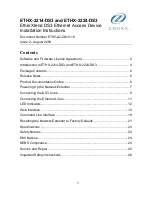
INS_CWGE24MS2_REV–
10/05/16 PAGE 96
INSTALLATION AND OPERATION MANUAL
CWGE24MS2
TECH SUPPORT: 1.888.678.9427
Parameter
Description
Port
Select a port number to configure its port isolation settings.
Select All Ports to configure the port isolation settings for all ports on the Switch.
Egress Port
An egress port is an outgoing port, that is, a port through which a data packet leaves.
Selecting a port as an outgoing port means it will communicate with the port
currently being configured.
Select All/
Deselect All
Click Select All to mark all ports as egress ports and permit traffic.
Click Deselect All to unmark all ports and isolate them.
Deselecting all ports means the port being configured cannot communicate with any
other port.
Apply
Click Apply to configure the settings.
Refresh
Click this to reset the fields to the last setting.
Port Isolation Status “V” indicates the port’s packets can be sent to that port.
“-” indicates the port’s packets cannot be sent to that port.
802.1Q VLAN
Introduction
A virtual LAN, commonly known as a VLAN, is a group of hosts with a common set of
requirements that communicate as if they were attached to the Broadcast domain, regardless of
their physical location. A VLAN has the same attributes as a physical LAN, but it allows for end
stations to be grouped together even if they are not located on the same network switch. Network
reconfiguration can be done through software instead of physically relocating devices.
VID- VLAN ID is the identification of the VLAN, which is basically used by the standard 802.1Q. It
has 12 bits and allow the identification of 4096 (2^12) VLANs. Of the 4096 possible VIDs, a VID of
0 is used to identify priority frames and value 4095 (FFF) is reserved, so the maximum possible
VLAN configurations are 4,094.
A tagged VLAN uses an explicit tag (VLAN ID) in the MAC header to identify the VLAN
membership of a frame across bridges - they are not confined to the switch on which they were
created. The VLANs can be created statically by hand or dynamically through GVRP. The VLAN
ID associates a frame with a specific VLAN and provides the information that switches need to
process the frame across the network. A tagged frame is four bytes longer than an untagged
frame and contains two bytes of TPID (Tag Protocol Identifier, residing within the type/length
field of the Ethernet frame) and two bytes of TCI (Tag Control Information, starts after the source
address field of the Ethernet frame).
The CFI (Canonical Format Indicator) is a single-bit flag, always set to zero for Ethernet switches. If
a frame received at an Ethernet port has a CFI set to 1, then that frame should not be forwarded
as it is to an untagged port. The remaining twelve bits define the VLAN ID, giving a possible
maximum number of 4,096 VLANs. Note that user priority and VLAN ID are independent of each
















































